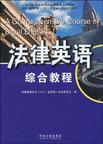法律英语综合教程
2009-10
中国法制出版社
法律英语证书(LEC)全国统一考试委员会 编
462
无
随着我国人世和改革开放程度不断加深,越来越多的外资进入中国市场,越来越多的中国企业走出国门寻找商机。无论是迎进来,还是走出去,这些企业所面临的一个共同问题就是法律问题,而这些法律问题中的大多数又都属于涉外法律的工作范畴。由于法律文化、法律条款的差异,中外双方在合作过程中不可避免的会出现许多矛盾分歧,减少、化解这些矛盾分歧需要沟通谈判,甚至需要通过法律手段来解决问题。所有这些工作都需要法律工作者通过专业外语完成。因此,在国际化趋势日见凸显的今天,掌握专业外语已经成为法律人必备的职业素质。 众所周知,美国法是英美法系的典型代表,其法律体系完整、内容丰富,既有传统的普通法,又有新兴的成文法;既有统一的联邦法,又有各州的法律。同时,美国法在世界范围内影响深远,学习研究美国法意义重大,这不仅表现为许多国家都在研究美国的法律规则,借鉴其成熟做法,还表现为许多国际公约也参照美国法的理念、原则、规则制定。 因此,本书作为学习法律英语的精读教材,主要介绍美国法,希望读者通过学习权威、实用的美国法律知识,掌握地道、纯正的法律英语。一般的语言教材都会系统的讲授语法知识,但本书的编写设想学生已经完成了从中学英语到大学一、二年级的基础英语学习,系统掌握了英语语法等基础知识并有不低于六千英语词汇量。本书具有以下特点: 首先,编者参考了大量的美国原版法学书籍,包括美国法学院教材及大量判例,力求实现教材内容的权威性和丰富性。 其次,本书引用了许多极具代表性的英文案例。英美法系是判例法系,无论是法官还是律师都特别注重对判例的研究,因此学习美国法不能绕过案例,通过研究案例更有利于掌握标准的法律英语,也更容易掌握美国法的精髓。本书选取了十几个经典案例,以期最大程度的展现美国法原貌。 再次,本书在每部分后面都附有相关的练习题,以期帮助读者检查自己学习掌握法律英语术语、基础美国法知识和逻辑推理知识的程度,查漏补缺。 本书共分十三部分。第一、二部分首先介绍了基本法律英语词汇的特点、美国的法律体系,这是学好法律英语的基础。
随着我国入世和世界经济一体化进程的不断加快,国际交流合作日益增多,涉外法务活动空前频繁,法律英语的重要性日益凸显。掌握专业英语已经成为现代法律人必备的职业素质。由于法律英语的特殊性,国内一直没有一个科学的考核指标衡量法律从业人员专业英语的掌握程度。法律英语证书(LEC)全国统一考试的推出为我国法律英语的教与学指明了方向,意义重大,影响深远。
Part One Basics of Legal EnglishChapter 1 IntroductionChapter 2 Historical Development of Legal EnglishChapter 3 Characteristics of Legal EnglishChapter 4 Terms and Rules in Legal EnglishChapter 5 General Legal TermsChapter 6 Legal CitationsPart Two American Legal RegimeChapter 1 Overview of the U. S. Court SystemChapter 2 Jury TrialChapter 3 The Adversary SystemChapter 4 Appellate CourtsChapter 5 Appellate JudgesChapter 6 Court Opinions and Case DigestsPart Three Constitutional LawChapter 1 IntroductionChapter 2 The Judicial PowerChapter 3 Legislative PowerChapter 4 Individual Guarantees Against Governmental or PrivateActionChapter 5 Retroactive LegislationChapter 6 Procedural Due ProcessChapter 7 Substantive Due ProcessChapter 8 Equal ProtectionChapter 9 Fundamental RightsPart Four ContractsChapter 1 IntroductionChapter 2 Basics of ContractsChapter 3 Contract FormationChapter 4 Capacity of a ContractChapter 5 Vitiating FactorsChapter 6 Problems Involving Persons Other than the Parties to the Original ContractChapter 7 DischargeChapter 8 Breach of ContractChapter 9 Remedies for Breach of ContractChapter 10 Dispute SettlementPart Five TortsChapter 1 IntroductionChapter 2 Intentional TortsChapter 3 Defenses to Intentional TortsChapter 4 NegligenceChapter 5 Cause in FactChapter 6 Proximate CauseChapter 7 Multiple TortfeasorsChapter 8 Damages for Personal InjuriesChapter 9 Limited Duties : Special Limitations on the Scope of DutyChapter 10 Premises Liability: Duties of Owners and Occupiers of LandChapter 11 DefensesChapter 12 Vicarious LiabilityChapter 13 Products LiabilityChapter 14 DefamationChapter 15 The Privacy TortsChapter 16 Competitive TortsPart Six Property LawChapter 1 IntroductionChapter 2 Acquisition of PropertyChapter 3 Possessory EstatesChapter 4 Future InterestsChapter 5 Concurrent EstatesChapter 6 Landlord and TenantChapter 7 FixturesChapter 8 Rights in the Land of Another Easements, Profits, Covenants, and ServitudesChapter 9 ConveyancingChapter 10 Cooperatives, Condominiums, and ZoningChapter 11 NuisancePart Seven Evidence LawChapter 1 IntroductionChapter 2 General ConsiderationsChapter 3 Relevance and Judicial NoticeChapter 4 Real EvidenceChapter 5 Documentary EvidenceChapter 6 Testimonial EvidenceChapter 7 The Hearsay RuleChapter 8 Procedural ConsiderationsPart Eight Civil ProcedureChapter 1 IntroductionChapter 2 Personal JurisdictionChapter 3 Diversity of Citizenship JurisdictionChapter 4 Federal Question JurisdictionChapter 5 VenueChapter 6 Removal JurisdictionChapter 7 Conflict of Jurisdiction between States and Federal CourtsChapter 8 The Federal Rules of Civil ProcedurePart Nine Criminal LawChapter 1 IntroductionChapter 2 What Makes a Case a Criminal Case?Chapter 3 How to Interpret Criminal StatutesChapter 4 How Defendants Mental States Affect Their Responsibility for a CrimeChapter 5 Criminal OffensesChapter 6 Implications of a Crimes ClassificationPart Ten Criminal ProcedureChapter 1 Constitutional RestrainsChapter 2 Exclusionary RuleChapter 3 Fourth AmendmentChapter 4 ConfessionsChapter 5 Pretrial ProceduresChapter 6 TrialChapter 7 Guilty Pleas and Plea BargainingChapter 8 Constitutional Rights in Relation to Sentence and PunishmentChapter 9 Constitutional Problems on AppealChapter 10 Rights during Punishment-Probation, Imprisonment, ParoleChapter 11 Double JeopardyChapter 12 Forfeiture ActionsPart Eleven Intellectual Property LawChapter 1 IntroductionChapter 2 Trade SecretsChapter 3 PatentChapter 4 CopyrightChapter 5 Trademark LawPart Twelve Business LawChapter 1 Introduction to Business FormsChapter 2 PartnershipChapter 3 Limited Liability CompanyChapter 4 CorporationChapter 5 SecuritiesChapter 6 Commercial PaperPart Thirteen Logical ReasoningChapter 1 IntroductionChapter 2 AssumptionsChapter 3 Method of ArgumentChapter 4 Faulty LogicChapter 5 Strengthening or WeakeningChapter 6 Parallel ReasoningChapter 7 InferenceChapter 8 Other Question TypesAppendix: Key to the ExercisesReferences
The field of torts embraces a group of civil wrongsother than breach of contractthat inter-fore with person,property,reputation,or may sometimes be both a crime punishable by the statein a criminal prosecution and also a tort actionable by the victim in a suit for damages.Thecriminal prosecution and the damage action are quite separate and unrelated proceedings.Theessential purpose of the law of torts is compensatory and,though punitive damages may occa.sionally be awardedits essentially punitive and an injured party is not awarded compensation inthe criminal proceeding. Tort law is chiefly state rather than federal law and so varies somewhat throughout thecountry. It may also be helpful to know something of the intellectual history of tort law in the UnitedStates.The following excerpt is only a small introduction to the fascinating subject: The emergence of Torts as an independent branch of tort law cflllle strikingly late in Ameri.can legal history.Although William Blackstone and his eighteenth-century contemporaries,intheir efforts to classify the law,identified a residual category of noncriminal wrongs not arisingout of contract,Torts was not considered a discrete branch of law until the late nineteenth cen.tury.The first American treatise on Torts appeared in 1 859;Torts was first taught as a separatelaw school subject in 1870;the first了orts casebook was published in 1874。 A standard explanation for the emergence of an independent identity for Torts late in the nineteenth century is the affinity of tort doctrines,especially negligence,to the problems produced by industrialization.The process by which Torts emerged as a discrete branch of law was more complex,however,and less dictated by the demands of industrial enterprise than the standard account suggests.Changes associated with industrial enterprise did provide many more cases involving strangers,a phenomenon that played a part in the emergence of Torts as all in.dependent branch of law.But even this new increase in cases in which the litigants had no priorrelationship would not have been sufficient had it not come at a time when legal scholars were prepared to question and discard old bases of legal classification.The emergence of Torts as adistinct branch of law owed as much to changes in jurisprudential thought as to the spread of the industrialization. ”Civil Uabmty”vs.”Criminal Guilt” Someone can be”liable”for a tort.That person has tort liability,and may be liable to paydamages to the injured party.In criminal law’however,someone may be”guilty”of a crime. There are some other differences between tort law and criminal law.Tort actions arebrought by private parties,while criminal actions can only be brought by the state or federalgovernment.Damages in a tort action are awarded to the plaintiff,while a fine assessed against acriminal defendant is paid to the state or federal government.
《法律英语综合教程》引用了许多极具代表性的英文案例。英美法系是判例法系,无论是法官还是律师都特别注重对判例的研究,因此学习美国法不能绕过案例,通过研究案例更有利于掌握标准的法律英语,也更容易掌握美国法的精髓。《法律英语综合教程》选取了十几个经典案例,以期最大程度的展现美国法原貌。 随着我国入世和世界经济一体化进程的不断加快,国际交流合作日益增多,涉外法务活动空前频繁,法律英语的重要性日益凸显。掌握专业英语已经成为现代法律人必备的职业素质。由于法律英语的特殊性,国内一直没有一个科学的考核指标衡量法律从业人员专业英语的掌握程度。法律英语证书(LEC)全国统一考试的推出为我国法律英语的教与学指明了方向,意义重大,影响深远。

无